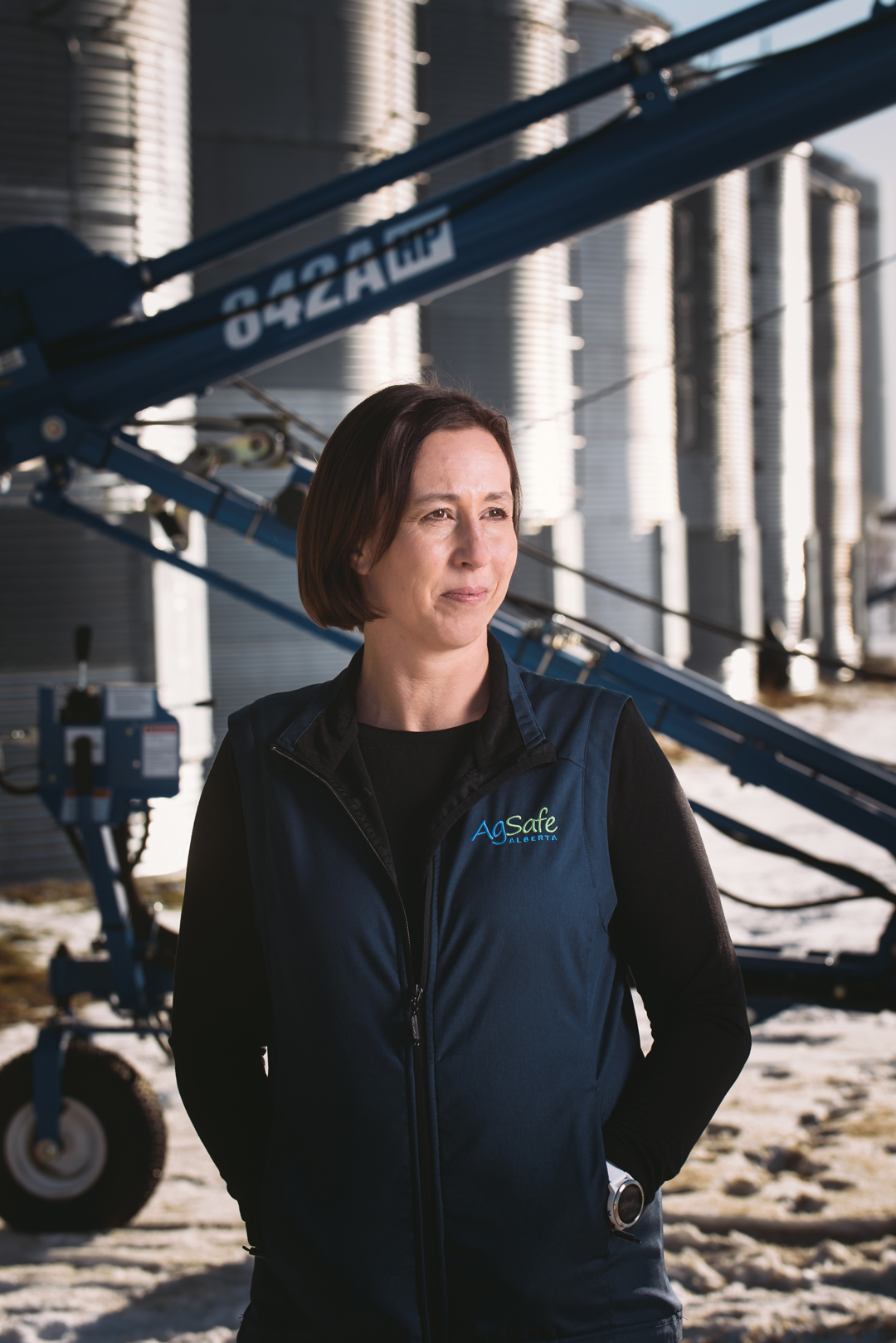SAFETY FIRST
BY ELLEN COTTEE • PHOTOS BY ROB McMORRIS
Like most farmers, Jody Wacowich’s parents made efforts to be safe at their Redwater cow-calf operation. But when she was growing up on the family farm in the ’80s and ’90s, the safety culture of the day didn’t go above and beyond. She saw her share of preventable accidents and understood the difficulty in convincing those set in their ways that there was room for improvement.
An agrologist who holds an MBA in agriculture from the University of Guelph, Wacowich has worked in business management and agricultural risk management and as an Olds College instructor. She also helped her father launch a new tree watering business with a heavy safety component. If she could get him to take safety to the next level, she said with a laugh, anyone could be convinced. Now serving as the executive director of AgSafe Alberta, she continues to assist farmers in making their operations as safe as possible.
GrainsWest: How did you come to work for AgSafe?
Jody Wacowich: Aside from looking for a new challenge, I was also a director for my dad’s tree watering business after he retired from the farm. The business was required to complete a safety certificate. My dad couldn’t deal with that, so I attended the sessions with him. I sat down with the books and we developed his safety plan. This is where I have experience with farmers who don’t really want to discuss safety all that much.
GW: What obstacles keep farmers from updating safety practices?
JW: I think it’s that we’ve asked farmers to be experts in everything on the farm. You need to know how to market your products, how to navigate food safety and quality, you need to be a mechanic and a welder. Every time we turn around, there’s something else that farmers need to know.
GW: Implementing anything new on the farm can be a challenge. What can make it easier?
JW: The challenge is trying to find a way to make safety plans practical and easy to start. That’s what we’re trying to do with AgSafe. We’re helping farmers start with small pieces, like emergency response. I’ll ask farmers how many of their kids have fire drills at school and know what to do, and of course everyone puts up their hand. But if I ask how many people on the farm know where to go and what to do in an emergency, they realize they hadn’t even thought about that.
GW: How can safety plans be less intimidating?
JW: A full safety plan seems overwhelming but, in some cases, farmers have done things that are in the plan. If they’re doing the Environmental Farm Plan, they’ve probably designed an emergency plan at the gate for responders. That’s a great start.
Quality assurance and food safety plans are another good one. Farmers will have operating procedures in place to meet those plans. Sometimes it’s as easy as tweaking what you have to include all employees, and it’s ready to go. For the quality assurance, they may have a procedure in place to ensure food quality, they would just need to also address any hazards to the employee.
GW: AgSafe offers resources and tools for farmers. How do these help contribute to safety plans?
JW: We offer tools that make it easy to start, like the Quick Start Guide. Let’s not start saying we’re going to build a whole plan. Let’s take a piece and start thinking about what we could do to accomplish that. If you talk to people in other industries who are building full safety plans, it takes time. That’s really the key part of this: you’re not going to get it all done at once.
GW: Are you seeing more general interest in safety?
JW: We’re seeing increased uptake on our website, certainly around announcements. Last June, when the technical rules were coming out, farmers were on our website to find information. Again, in December 2018, when the rules were coming into effect, farmers were again going, “OK, what does that mean? What do I have to do?” We made sure to put out documents detailing what changed with these new safety bills.
GW: There have been plenty of changes to provincial farm safety legislation over the past five years, most recently, the implementation of Bill 26, the Farm Freedom and Safety Act. How has AgSafe supported farmers through these changes?
JW: Every time legislation changes regarding farm safety, there is confusion, and AgSafe receives calls and emails from farmers asking what the legislation means for them. For example, the Occupational Health and Safety (OHS) Act still applies to farms and ranches but the regulations and code under the Act do not. What is the difference, and what do I have to do? Some farmers wonder which rules apply to their farm.

AgSafe resources and tools such as its Quick Start Guide make farm safety planning easier.
GW: What other AgSafe resources are available to farmers?
JW: We’re developing a web portal so farmers will be able to log in and take some courses to introduce them to building farm safety plans. There are tools and templates available to get started. The government used to do a two-day workshop. We brought it down to a half-day or one-day workshop, depending on the size of your farm and what you need to do. Then, if the farmer has completed the e-learning in the online portal and learned definitions and other pieces, they can come to the workshop and start building their hazard assessments and other tools with the support of someone from AgSafe.
GW: What are the most important parts of on-farm safety for farmers to consider?
JW: One of the requirements under the OHS Act is to identify the hazards on your farm. Then you can decide what you will do to eliminate or reduce the risk of hazards. That’s certainly a good place to start. The other one is having your emergency response ready. As the owner of the farm, you can describe every land location and specific quarter. But if somebody is working for you out on one of those pieces and gets into trouble and needs to call for help or call an ambulance, can they describe their location? Is the information handy in the cab of the tractor or combine for them to tell emergency services?
GW: Has your perception of on-farm safety changed since joining AgSafe?
JW: In safety circles, it’s referred to as the iceberg theory: for every dollar in direct cost of an accident or incident, there is somewhere between $5 to $50 in other costs that you don’t directly see for that incident. Perhaps downtime fixing the equipment, insurance costs and other factors.
As farmers, we manage risk for prices, markets and weather. We have to think about safety as the same sort of thing. What’s the most valuable resource on your farm? It’s not the buildings or machinery, it’s the people. We want to mitigate that risk and keep them safe.







Comments